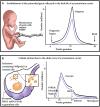Fragile X-Associated Diminished Ovarian Reserve and Primary Ovarian Insufficiency from Molecular Mechanisms to Clinical Manifestations
- PMID: 28955201
- PMCID: PMC5600956
- DOI: 10.3389/fnmol.2017.00290
Fragile X-Associated Diminished Ovarian Reserve and Primary Ovarian Insufficiency from Molecular Mechanisms to Clinical Manifestations
Abstract
Fragile X syndrome (FXS), is caused by a loss-of-function mutation in the FMR1 gene located on the X-chromosome, which leads to the most common cause of inherited intellectual disability in males and the leading single-gene defect associated with autism. A full mutation (FM) is represented by more than 200 CGG repeats within the FMR1 gene, resulting in FXS. A FM is inherited from women carrying a FM or a premutation (PM; 55-200 CGG repeats) allele. PM is associated with phenotypes distinct from those associated with FM. Some manifestations of the PM are unique; fragile-X-associated tremor/ataxia syndrome (FXTAS), and fragile-X-associated primary ovarian insufficiency (FXPOI), while others tend to be non-specific such as intellectual disability. In addition, women carrying a PM may suffer from subfertility or infertility. There is a need to elucidate whether the impairment of ovarian function found in PM carriers arises during the primordial germ cell (PGC) development stage, or due to a rapidly diminishing oocyte pool throughout life or even both. Due to the possibility of expansion into a FM in the next generation, and other ramifications, carrying a PM can have an enormous impact on one's life; therefore, preconception counseling for couples carrying the PM is of paramount importance. In this review, we will elaborate on the clinical manifestations in female PM carriers and propose the definition of fragile-X-associated diminished ovarian reserve (FXDOR), then we will review recent scientific findings regarding possible mechanisms leading to FXDOR and FXPOI. Lastly, we will discuss counseling, preventative measures and interventions available for women carrying a PM regarding different aspects of their reproductive life, fertility treatment, pregnancy, prenatal testing, contraception and fertility preservation options.
Keywords: FMR1 premutation carriers; diminished ovarian reserve; fragile X syndrome; fragile-X-associated diminished ovarian reserve; fragile-X-associated primary ovarian insufficiency.
Figures

Similar articles
-
FMR1 Disorders.1998 Jun 16 [updated 2024 May 16]. In: Adam MP, Feldman J, Mirzaa GM, Pagon RA, Wallace SE, Amemiya A, editors. GeneReviews® [Internet]. Seattle (WA): University of Washington, Seattle; 1993–2025. 1998 Jun 16 [updated 2024 May 16]. In: Adam MP, Feldman J, Mirzaa GM, Pagon RA, Wallace SE, Amemiya A, editors. GeneReviews® [Internet]. Seattle (WA): University of Washington, Seattle; 1993–2025. PMID: 20301558 Free Books & Documents. Review.
-
Presence of inclusions positive for polyglycine containing protein, FMRpolyG, indicates that repeat-associated non-AUG translation plays a role in fragile X-associated primary ovarian insufficiency.Hum Reprod. 2016 Jan;31(1):158-68. doi: 10.1093/humrep/dev280. Epub 2015 Nov 3. Hum Reprod. 2016. PMID: 26537920 Free PMC article.
-
Ovarian reserve in patients with FMR1 gene premutation and the role of fertility preservation.Ann Endocrinol (Paris). 2024 Jul;85(4):269-275. doi: 10.1016/j.ando.2024.04.004. Epub 2024 May 1. Ann Endocrinol (Paris). 2024. PMID: 38702011
-
An explanation of the mechanisms underlying fragile X-associated premature ovarian insufficiency.J Assist Reprod Genet. 2020 Jun;37(6):1313-1322. doi: 10.1007/s10815-020-01774-x. Epub 2020 May 6. J Assist Reprod Genet. 2020. PMID: 32377997 Free PMC article.
-
Fragile X spectrum disorders.Intractable Rare Dis Res. 2014 Nov;3(4):134-46. doi: 10.5582/irdr.2014.01022. Intractable Rare Dis Res. 2014. PMID: 25606363 Free PMC article. Review.
Cited by
-
Metabolic Alterations in FMR1 Premutation Carriers.Front Mol Biosci. 2020 Sep 18;7:571092. doi: 10.3389/fmolb.2020.571092. eCollection 2020. Front Mol Biosci. 2020. PMID: 33195417 Free PMC article. Review.
-
Understanding the Mechanisms of Diminished Ovarian Reserve: Insights from Genetic Variants and Regulatory Factors.Reprod Sci. 2024 Jun;31(6):1521-1532. doi: 10.1007/s43032-024-01467-1. Epub 2024 Feb 12. Reprod Sci. 2024. PMID: 38347379 Review.
-
Defining the role of FMR1 gene in unexplained recurrent spontaneous abortion.J Assist Reprod Genet. 2019 Nov;36(11):2245-2250. doi: 10.1007/s10815-019-01591-x. Epub 2019 Oct 17. J Assist Reprod Genet. 2019. PMID: 31625034 Free PMC article.
-
FMR1 allelic complexity in premutation carriers provides no evidence for a correlation with age at amenorrhea.Reprod Biol Endocrinol. 2024 Jun 21;22(1):71. doi: 10.1186/s12958-024-01227-5. Reprod Biol Endocrinol. 2024. PMID: 38907244 Free PMC article.
-
Recent advances in understanding primary ovarian insufficiency.F1000Res. 2020 Sep 7;9:F1000 Faculty Rev-1101. doi: 10.12688/f1000research.26423.1. eCollection 2020. F1000Res. 2020. PMID: 32934798 Free PMC article. Review.
References
-
- Albright F., Smith P., Fraser R. (1942). A syndrome characterized by primary ovarian insufficiency and decreased stature. Am. J. Med. Sci. 204, 625–648. 10.1097/00000441-194211000-00001 - DOI
-
- Allingham-Hawkins D. J., Babul-Hirji R., Chitayat D., Holden J. J., Yang K. T., Lee C., et al. . (1999). Fragile X premutation is a significant risk factor for premature ovarian failure: the international collaborative POF in fragile X study—preliminary data. Am. J. Med. Genet. 83, 322–325. 10.1002/(sici)1096-8628(19990402)83:4<322::aid-ajmg17>3.3.co;2-2 - DOI - PMC - PubMed
Publication types
LinkOut - more resources
Full Text Sources
Other Literature Sources

